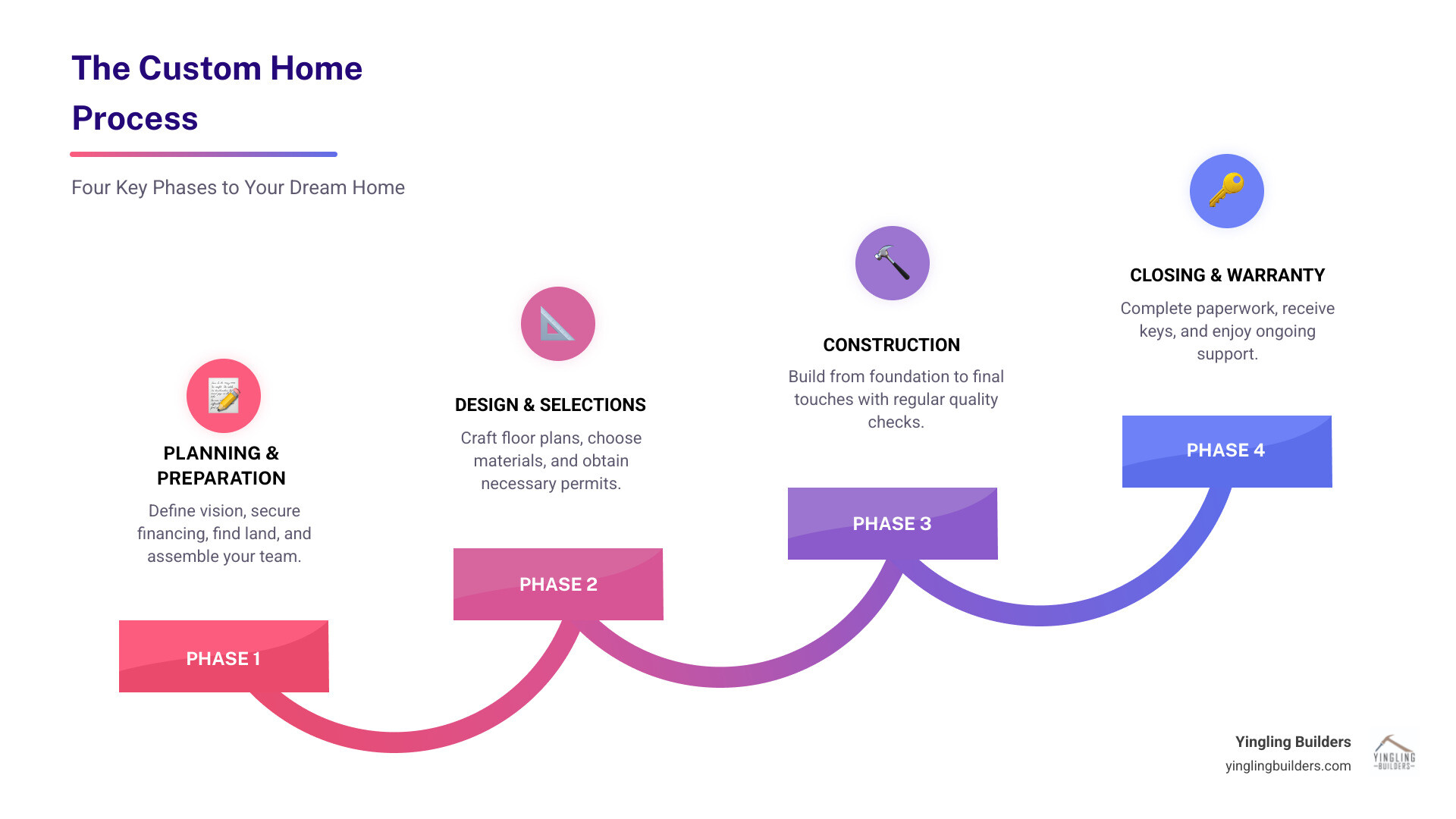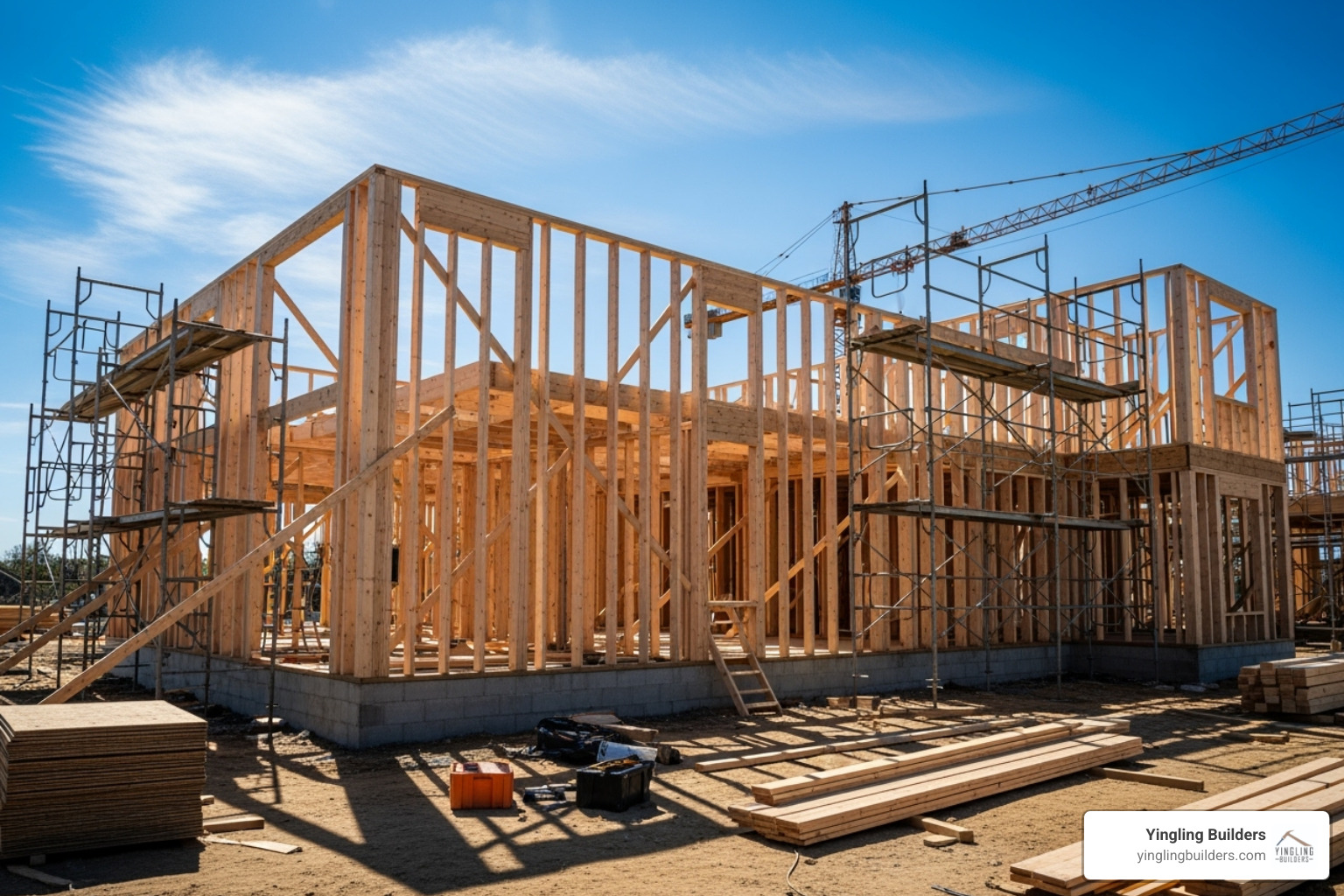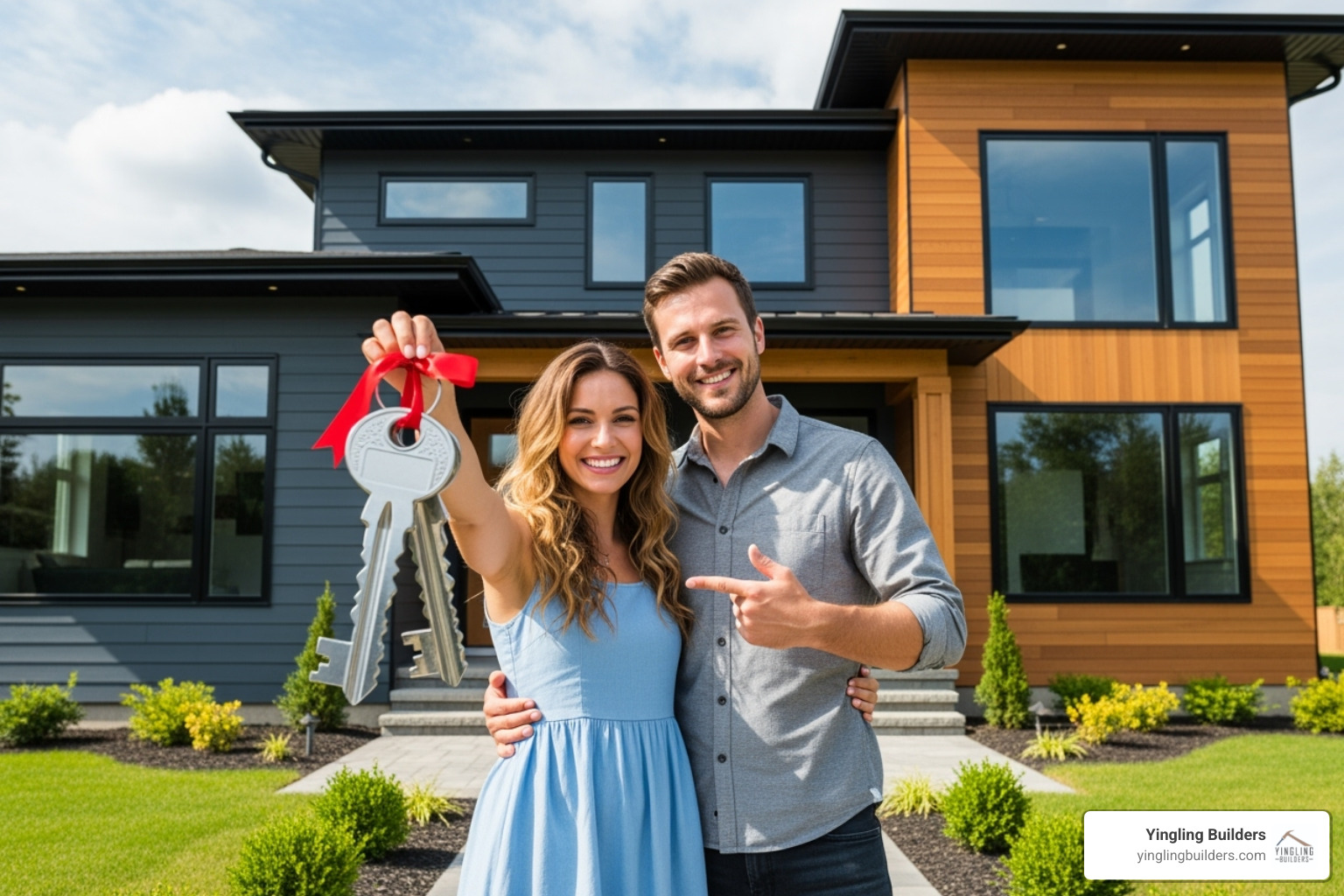Why the Custom Home Process Feels Overwhelming (And How to Make It Simple)
The custom home process involves four main phases that take you from initial vision to move-in day:
- Planning & Preparation – Define your vision, secure financing, find land, and assemble your team
- Design & Selections – Create floor plans, choose materials and finishes, obtain permits
- Construction – Build from foundation to final touches with regular quality checks
- Closing & Warranty – Complete paperwork, receive keys, and enjoy ongoing support
Building a custom home is an exciting journey where you create exactly what you want, from the kitchen layout to the master suite. But the process can feel overwhelming. With 35 to 50 critical decisions in the design phase alone, plus financing and permits, it’s easy to feel lost.
The good news is that thousands of families successfully steer this journey every year. The key is understanding the process and having the right team to guide you.
This guide breaks down the entire custom home building process into clear, manageable phases. You’ll learn what to expect and how to avoid the common pitfalls that trip up first-time builders.
I’m Seth Yingling, and I’ve been helping families in West Central Illinois steer the custom home process for over 15 years. After founding Yingling Builders in 2019 and earning Premier Builder status with Wausau Home Products, I’ve seen how the right approach transforms a stressful experience into an exciting journey toward your dream home.

Phase 1: Laying the Groundwork (Planning & Preparation)

Think of this as the foundation for everything that follows. Before breaking ground, we need to get clear on what you want, how much you can spend, and where you’ll build. This is where your dreams start becoming real plans. The excitement is real, but so is the homework. We’ll walk through each step together, ensuring you feel confident about every decision.
Defining Your Vision & Budget
Start by dreaming about your perfect home, but distinguish between non-negotiables (like an open kitchen) and nice-to-haves (perhaps a wine cellar). We get to know how you live to ensure your home’s design reflects your lifestyle preferences. Do you host big dinners? Work from home? These details shape the layout.
Next comes the reality check: your budget. Getting this right from the start prevents heartache later. Budget creep is real, happening when exciting upgrades add up. We’ll help you understand allowances (set amounts for items like flooring and lighting) and discuss potential hidden costs, like site work for rocky soil. Don’t forget permits and landscaping are part of your total investment. For a complete breakdown, see our guide on Budgeting for a Custom Build: What You Need to Know.
Securing Your Construction Financing
Unlike a traditional mortgage, a construction loan funds a home that hasn’t been built yet. The bank releases money in stages as we hit specific milestones—foundation complete, framing done, etc. You typically pay only interest during construction, keeping payments manageable.
Many of our clients prefer construction-to-perm loans (or single closing loans). Instead of two separate loans and closings, everything is streamlined into one process. You close once, and the loan converts to a permanent mortgage when construction is complete. The single closing benefits are significant: one set of closing costs, one credit check, and one rate lock. Lender requirements usually include a good credit score, stable income, and a reasonable debt-to-income ratio. Getting pre-qualified early helps you know what you can afford. To learn more about how these loans work, the Consumer Financial Protection Bureau offers a helpful overview.
Finding the Perfect Piece of Land
If you don’t own land, finding the right spot is like framing a masterpiece. It’s about more than just a pretty view. If you don’t own land, finding the right spot is like framing a masterpiece. It’s about more than just a pretty view.
First, understand the rules. Zoning regulations tell you what you can build, like height limits or specific architectural styles. Next, think about what’s underground. Utilities are crucial. Will you need a septic system or a well? Connecting to city services is often simpler, but not always an option. These choices impact your budget and timeline.
The land itself matters. Topography – how flat or sloped it is – affects design and cost. A sloped lot might be great for a walkout basement, but rocky ground means more expensive excavation.
Also, consider legal boundaries and restrictions. We look at setbacks (how close you can build to property lines), easements (rights for others to use part of your land), and any HOA guidelines. Owning an acre doesn’t mean you can build on all of it. Wetlands or steep slopes can limit your buildable space.
Sometimes, the perfect land is already part of a thoughtfully planned community. For example, we offer options like those found at Neylon Farms, a housing initiative in Mt. Sterling.
For more insights on land selection, explore our guide on What to Consider Before Building Your Dream Home.
Assembling Your Dream Team for the Custom Home Process
Choosing the right team is critical. At Yingling Builders, we’re a design-build firm, handling both design and construction under one roof. This integrated approach eliminates communication gaps and surprises. When vetting builders, look beyond their portfolio. Ask about their communication style and how they handle problems. You want a builder who is transparent, returns calls, and explains things clearly. The importance of communication can’t be overstated. A good real estate agent specializing in land can also be invaluable. For more questions to ask, see our guide on Luxury Home Builders: Questions. The right team makes the custom home process exciting, not exhausting.
Phase 2: From Dream to Blueprint (Design & Selections)

This is where your dream takes shape on paper. The design phase is an exciting, collaborative time where we plan every detail of your future home, setting the stage for a smooth construction process.
Crafting Your Perfect Floor Plan
Your floor plan is the heart of your home, designed for your specific lifestyle. Whether you dream of an open-concept living space or need a dedicated home office, we’ll help you create the perfect layout. While we can design a unique home from scratch, many families start with our award-winning floor plans. This approach often leads to clearer cost estimates and helps avoid “budget creep,” keeping your project on schedule.
No matter our starting point, the goal is personalization. We’ll discuss room function, architectural style, and how everything flows together to create a cohesive and comfortable home. See how we bring designs to life in our approach to Custom Home Design.
Making Your Selections: From Fixtures to Finishes
This is the fun—and sometimes overwhelming—part. You’ll make roughly 35 to 50 critical decisions about everything from exterior siding and roofing to interior paint, flooring, cabinetry, countertops, and lighting. It’s a lot to consider!
To make this process enjoyable, we invite you to our centralized design center. Here, you can see all the samples in one place and coordinate finishes, often with a professional designer’s guidance. This avoids the stress of juggling appointments with multiple vendors. We’ll walk you through our Style Guide and help you explore options like Trending Flooring to ensure every choice reflects your taste and budget. Your timely decisions are crucial for keeping the custom home process on track.
Navigating Permits, Regulations, and Local Codes
Before construction begins, we must secure all necessary permits and ensure the design complies with local regulations. This part of the custom home process can be underestimated; in West Central Illinois, obtaining permits can take one to three months or longer, depending on the project’s complexity.
Our team handles this for you. We ensure your plans meet all local building codes, zoning laws, and architectural guidelines. This includes:
- Securing building permits from the local government.
- Conducting a thorough site evaluation to ensure the home fits the land’s unique features.
- Ensuring compliance with all safety and structural standards.
We manage the paperwork and submissions, working with local authorities to secure permits efficiently. This gives you peace of mind that your home will be built safely, legally, and to the highest standards.
The Complete Custom Home Process: From Foundation to Finishes

With plans approved and permits in hand, the magic begins. This is the construction phase, where your blueprint becomes a tangible structure. It’s a systematic custom home process that we manage with precision and clear communication. You can track your home’s progress on our Home Construction page.
Step 1: Site Prep & Foundation
The first on-site step is preparing the ground. This involves excavation for the foundation and basement, followed by grading the land to ensure proper drainage. We also handle utility hookups for water, sewer or septic, and electricity. Then, we pour the concrete footings that support the foundation walls. Finally, we construct the foundation walls, creating the sturdy base for your home. A strong foundation ensures your home’s stability for decades. Learn more about this crucial stage on our Construction Building page.
Step 2: Framing & “Drying In”
With the foundation complete, we begin framing the skeleton of your house. This includes installing the floor systems, erecting exterior and interior walls, and setting the roof trusses. We then apply sheathing to the exterior walls and roof. The next focus is “drying in” the home by installing windows, exterior doors, and roofing materials. This vital step makes the structure watertight, protecting the interior from the elements.
Step 3: The Mechanical Rough-In
Next, we install the home’s essential systems. During this “rough-in” phase, we run plumbing lines for water and drainage, lay electrical wiring for outlets and lights, and install HVAC systems and ductwork. Before the walls are closed up, we’ll conduct a pre-drywall walk-through with you. This is your chance to see the home’s “guts” and confirm everything is placed correctly. We also complete all municipal inspections to ensure everything is up to code. For more detail, see Custom Home Steps.
Step 4: Interior & Exterior Finishes
This phase focuses on the aesthetic and functional elements that define your home’s character. We install insulation for energy efficiency, then hang and finish drywall to create smooth interior surfaces. We add polished details with interior trim like baseboards and door casings. On the outside, we apply your chosen siding and exterior details. Inside, we install flooring, cabinets, and countertops. Finally, painting brings your color selections to life, changing the structure into your personalized space. The Claybrook Haven is a great example of how these finishes come together.
Step 5: Final Touches & Quality Walkthrough
In the final stage, we install light fixtures, plumbing fixtures (faucets, sinks, toilets), and appliances. Outside, we complete the final grading and landscaping, including walkways and sod. Before handing over the keys, we conduct a thorough final quality walk-through with you to create a “punch list” of any minor items needing a final touch. We also provide a comprehensive homeowner orientation to teach you how to operate and maintain your new home’s systems. Your dream home is finally ready!
The Finish Line: Closing, Warranties, and Life in Your New Home

The construction dust has settled, and your dream home is ready. This final phase is about making it officially yours and ensuring you feel supported long after you move in.
The Closing Process: Getting Your Keys
Closing is the final legal step where ownership of your new home is transferred to you. It’s the culmination of the entire custom home process. You’ll sign important paperwork, including mortgage documents and the title transfer. We’ll be there to guide you through the documents and answer any questions. Once everything is signed and funds are disbursed, you’ll get the keys to your new home. Congratulations, it’s officially yours!
Understanding Your Home Warranty After the Custom Home Process
Our commitment continues after you move in. We stand behind our work with a comprehensive warranty program for your peace of mind. This includes a full one-year workmanship warranty covering the quality of our work and materials. For long-term confidence, we also provide a 10-year transferrable structural warranty on major components.
Additionally, many products like appliances and windows come with their own manufacturer warranties. We believe in proactive support, so we schedule a 90-day follow-up and an 11-month warranty visit to address any questions or adjustments after you’ve lived in the home through a full cycle of seasons. We have a clear system for reporting any issues, and our team is committed to addressing them promptly. Our dedication to quality is built on faith, as we share in Building a Home with Faith.
Frequently Asked Questions About Building a Custom Home
Building a custom home brings up lots of questions. After helping families through the custom home process for over 15 years, I’ve heard just about every concern. Here are the three that come up most often.
How long does it really take to build a custom home?
This is our most common question, and the answer depends on several factors. A realistic timeline is 12 to 18 months from contract to keys, though simpler builds can take as little as 10 months and more complex homes up to 24 months.
A typical breakdown is:
- Design Phase (4-8 months): This includes creating floor plans and making material selections. Your decision-making speed is a major factor here.
- Permitting (1-3+ months): This can be a wild card. We handle the paperwork to keep it moving.
- Construction (6-15 months): This depends on your home’s size and complexity.
Other factors like weather, material availability, and the complexity of your design can also influence the timeline. We work hard to order materials in advance and keep you informed to avoid delays.
What’s the difference between a custom home and a production home?
Understanding the difference between custom and production homes sets the right expectations. A production home is like buying a car off the lot; a custom home is like having one built specifically for you.
- Customization: With a custom home, your options are unlimited. Production homes offer limited choices from pre-set models.
- Lot Selection: You choose your own land for a custom home. Production builders work in pre-planned communities.
- Involvement: The custom process requires your active participation in countless decisions. The production process is more straightforward.
- Timeline: Custom homes take longer due to the extensive design and unique construction. Production homes are faster because the process is streamlined.
- Budgeting: Custom home budgets have more variables and allowances. Production homes have more predictable, package-based pricing.
Building custom requires more time and effort, but the result is a home that fits you perfectly. Learn more at Buying vs. Building: The Pros of Constructing Your Dream Home.
What are the most common pitfalls to avoid?
Knowing the common pitfalls of the custom home process can help you avoid them. Here are the biggest ones:
- Budget overruns: This often happens from underestimating costs or making too many changes during construction. We prevent this with transparent pricing and detailed allowances.
- Communication breakdowns: Misunderstandings lead to costly mistakes. We provide a dedicated point person and use online portals for real-time updates.
- Indecisiveness on selections: Delays in choosing finishes can derail the entire timeline. Our centralized design center and professional guidance streamline this process.
- Not vetting your builder properly: An inexperienced or poor communicator can turn your dream into a nightmare. Always check references and review their process.
- Unrealistic timeline expectations: A custom home takes longer than a production home. Understanding the realistic timelines for design and permitting helps you plan accordingly.
The key to avoiding these pitfalls is thorough planning, open communication, and working with a trusted, experienced builder.
Conclusion
Building a custom dream home is one of life’s most rewarding journeys. While the custom home process is complex, it becomes manageable and even enjoyable with the right team. This journey is about more than building a house; it’s about crafting a space that truly reflects who you are and how you live.
Success lies in understanding the process and partnering with a builder who prioritizes clear communication, transparent processes, and quality craftsmanship. At Yingling Builders, we’ve refined our approach over years of helping families in West Central Illinois. We believe the custom home process should be exciting, not overwhelming.
Our commitment is to educate, guide, and support you through every phase. From our first conversation to the warranty support after you’ve settled in, we’re dedicated to making your experience as smooth as possible.
Ready to turn your dream home into reality? Explore our Proven Custom Home Process to see how we make building straightforward and enjoyable. Or Contact Us today—let’s start a conversation about creating your perfect home in West Central Illinois.
Your dream home is waiting. Let’s build it together.

0 Comments